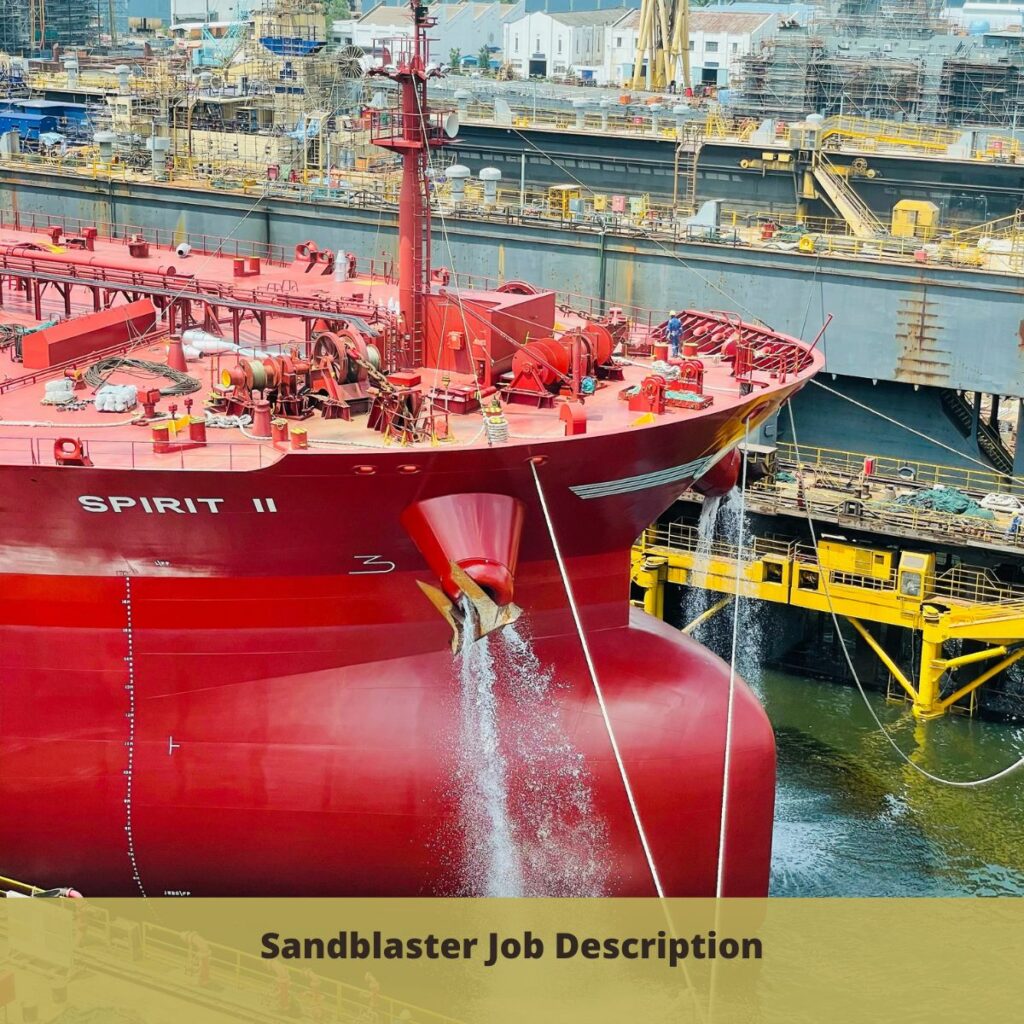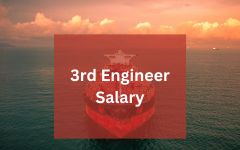Sandblaster Job Description
Are you looking for an exciting career opportunity in the marine industry? Have you ever considered a sandblaster job? If not, it's time to take a closer look at this fascinating role that combines cutting-edge technology with the beauty of the ocean.
In this article, we'll delve into the details of a marine sandblaster job, discussing what it involves, the necessary qualifications, and the rewards of pursuing this profession. So, if you're interested in a career that is both challenging and rewarding, read on!
What Is a Sandblaster Job?
Marine sandblasting jobs are an essential part of the maritime industry. The sandblaster job involves using a specialized device, the sandblaster, to clean and maintain the hulls of ships, boats, and other vessels. Sandblasters use high-pressure water jets and abrasive materials to remove dirt, rust, and other debris that accumulate on the hulls of vessels over time.

The primary goal of a marine sandblaster is to prevent corrosion, which can lead to structural damage and compromise the safety of the vessel. Sandblasting also improves the overall performance of the vessel by reducing drag and improving fuel efficiency.
The marine sandblaster job entails more than just operating the sandblaster. It requires a good understanding of the materials being used, the surfaces being cleaned, and the safety protocols involved. Safety is a top priority in the job, and sandblasting can be a dangerous job, so following all safety procedures is essential to minimize the risk of injury.
Aside from operating the sandblaster, a marine sandblaster job may involve setting up and taking down equipment, preparing surfaces for sandblasting, applying coatings to protect surfaces after sandblasting, conducting routine maintenance on equipment, and maintaining accurate records of work completed. A typical day for a marine sandblaster may involve working on several different vessels, each with its unique cleaning requirements. Some vessels may have delicate surfaces that require a gentler touch, while others may require more aggressive cleaning techniques.
To become a marine sandblaster, a high school diploma or equivalent is typically required. Some employers may require additional training or certification, such as a marine coatings applicator certification. Marine sandblasters should also possess good physical fitness and stamina, excellent hand-eye coordination, attention to detail, the ability to work well in a team, good communication skills, and a willingness to work in challenging environments. Some marine sandblasters may also need to hold a commercial driver's license (CDL) if they are required to operate heavy equipment or transport materials.
One of the major factors that make marine sandblasting an attractive career option is the competitive salary. According to the Bureau of Labor Statistics (BLS), the median annual wage for abrasive blasting and painting workers, which includes marine sandblasters , was $46,370 as of May 2020. The top 10% of earners in this field earned more than $72,500 annually. Salaries for marine sandblasters can vary based on location, experience, and type of vessel, with larger vessels generally paying more.
Job security is another advantage of pursuing a marine sandblaster career. The maritime industry is a growing industry, and there is a constant demand for skilled workers. The industry offers a stable work environment and opportunities for career advancement. With experience and additional training, marine sandblasters can progress to more senior roles within the industry.
Variety is another significant benefit of pursuing a marine sandblaster job. Working on different vessels and projects keeps the job interesting and challenging. Sandblasting jobs may require travel to different ports and locations, providing opportunities for new experiences and adventure.
What Does a Marine Sandblaster Job Entail?
A marine sandblaster job is an essential component of the maritime industry, as it involves cleaning and maintaining the hulls of ships, boats, and other vessels. The primary objective of a marine sandblaster is to prevent corrosion, which can lead to structural damage and compromise the safety of the vessel. Sandblasting also improves the overall performance of the vessel by reducing drag and improving fuel efficiency.
Sandblaster job is not limited to operating the sandblaster machine. It requires a good understanding of the materials being used, the surfaces being cleaned, and the safety protocols involved. Safety is a top priority in the job, and sandblasting can be a dangerous job, so following all safety procedures is essential to minimize the risk of injury.
The marine sandblaster job entails a variety of tasks, including:
- Preparing surfaces for sandblasting: Before the sandblasting process can begin, the surfaces must be adequately prepared. This involves removing any loose debris, dirt, or rust, and taping or masking off any areas that should not be sandblasted. The marine sandblaster must also inspect the surfaces for any defects or irregularities that may need to be addressed before sandblasting can begin.
- Operating the sandblaster machine: The sandblaster machine is the primary tool used in marine sandblasting jobs. It uses high-pressure water jets and abrasive materials to remove dirt, rust, and other debris that accumulate on the hulls of vessels over time. The marine sandblaster must have a good understanding of the sandblaster machine, including its operation, maintenance, and repair.
- Applying coatings to protect surfaces: After sandblasting, the surfaces must be protected from corrosion and other damage. The marine sandblaster may be required to apply coatings or other protective materials to the surfaces, ensuring their longevity and continued performance.
- Conducting routine maintenance on equipment: Sandblasting equipment must be regularly maintained to ensure its continued effectiveness and safety. The marine sandblaster may be responsible for conducting routine maintenance, including cleaning, oiling, and replacing worn or damaged parts.
- Maintaining accurate records: The marine sandblaster must keep accurate records of the work completed, including the materials used, the surfaces cleaned, and any defects or irregularities found. These records are critical for future reference and for ensuring that the job was completed to the required standards.
In terms of salary, the Bureau of Labor Statistics (BLS) reports that the median annual wage for abrasive blasting and painting workers, which includes marine sandblasters, was $46,370 as of May 2020. Salaries can vary based on location, experience, and type of vessel, with larger vessels generally paying more.
To become a marine sandblaster, a high school diploma or equivalent is typically required. Some employers may require additional training or certification, such as a marine coatings applicator certification. Marine sandblasters should also possess good physical fitness and stamina, excellent hand-eye coordination, attention to detail, the ability to work well in a team, good communication skills, and a willingness to work in challenging environments. Some marine sandblasters may also need to hold a commercial driver's license (CDL) if they are required to operate heavy equipment or transport materials.
What Qualifications Do You Need to Become a Marine Sandblaster?
A marine sandblaster is an important member of the maritime industry, responsible for maintaining the hulls of ships, boats, and other vessels. The sanblaster job requires specialized skills, knowledge, and experience, as well as adherence to strict safety protocols. If you are interested in pursuing a career as a marine sandblaster, here are some of the qualifications you will need:
- Education and Training: Most marine sandblasters have a high school diploma or equivalent. However, some employers may require additional education or training, such as certification in marine coatings application. Certification programs are offered by a variety of organizations, including the Society for Protective Coatings and the National Association of Corrosion Engineers. These programs provide training on the use of sandblasting equipment, protective coatings, and other essential skills.
- Physical Fitness: Sandblasting is a physically demanding job that requires good physical fitness and stamina. The job may involve long periods of standing, bending, and lifting heavy equipment. The marine sandblaster must also be able to work in confined spaces and uncomfortable positions, often in harsh weather conditions.
- Attention to Detail: Sandblasting requires a high degree of attention to detail. The marine sandblaster must be able to identify defects or irregularities in the surfaces being cleaned and determine the appropriate sandblasting techniques to use. They must also be able to recognize and adhere to safety protocols to minimize the risk of injury or damage to the vessel.
- Communication Skills: Marine sandblasters must have good communication skills, as they often work in teams and must be able to communicate effectively with other members of the crew. They must be able to understand and follow instructions and provide clear and concise feedback on their progress.
- CDL & Sandblaster Job: Some marine sandblasters may be required to hold a commercial driver's license (CDL) if they are required to operate heavy equipment or transport materials. Requirements for obtaining a CDL vary by state but generally involve passing a written exam and a skills test.
In terms of salary, marine sandblasters can earn a competitive wage. According to the Bureau of Labor Statistics, the median annual wage for abrasive blasting and painting workers, which includes marine sandblasters, was $46,370 as of May 2020. However, salaries can vary based on location, experience, and type of vessel, with larger vessels generally paying more.
In addition to formal qualifications, a successful marine sandblaster should possess:
While formal qualifications such as education and training are essential for becoming a marine sandblaster, there are also several personal qualities and skills that are important for success in this field. These qualities are essential for ensuring that the job is done safely, effectively, and efficiently. Here are some additional traits that a successful marine sandblaster should possess:
- Adaptability: Marine sandblasting can be a challenging job, as it often involves working in harsh and unpredictable conditions. Successful sandblasters should be adaptable and able to adjust their work practices to accommodate changing weather conditions or unforeseen circumstances.
- Problem-Solving Skills: Sandblasting requires the ability to identify problems and develop solutions quickly. A successful marine sandblaster should be able to analyze a situation, evaluate options, and choose the best course of action.
- Time Management: Marine sandblasters often work in teams and must complete projects within tight deadlines. Successful sandblasters should possess strong time management skills to ensure that they can complete their work on schedule.
- Attention to Safety: Safety is a top priority for marine sandblasters. Successful sandblasters should possess a strong sense of responsibility and a commitment to following all safety protocols and regulations to minimize the risk of injury or damage.
- Patience: Sandblasting can be a tedious and repetitive task that requires a lot of patience. Successful marine sandblasters should be able to maintain focus and precision for extended periods, even when the work becomes repetitive.
- Technical Skills: Sandblasting requires a lot of technical knowledge and experience. Successful sandblasters should possess a thorough understanding of sandblasting equipment and techniques, as well as an ability to troubleshoot and perform minor repairs.
- Teamwork: Marine sandblasting is often a team effort, and a successful sandblaster should possess strong teamwork skills. They should be able to work collaboratively with other members of the team, communicate effectively, and contribute to a positive team environment.
In terms of salary, marine sandblasters can earn a competitive wage. As mentioned earlier, the median annual wage for abrasive blasting and painting workers, which includes marine sandblasters , was $46,370 as of May 2020. However, salaries can vary based on location, experience, and type of vessel, with larger vessels generally paying more.
What Are the Rewards of Pursuing a Sandblaster Job?
Pursuing a sandblaster job can be a rewarding and fulfilling career choice. It offers a range of benefits, both tangible and intangible. Here are some of the rewards of pursuing a sandblaster job:
Sandblaster Job - The Salary:
As mentioned earlier, the median annual wage for abrasive blasting and painting workers, which includes marine sandblasters, was $46,370 as of May 2020. Salaries can vary based on experience, location, and type of vessel, but a sandblaster job can offer a competitive salary and job security.
Sandblaster Job and Variety:
Sandblasting is a diverse field with a wide range of job opportunities. Sandblasters can work on different types of vessels, including cargo ships, tankers, and naval vessels, which can offer different challenges and learning opportunities.
Sandblaster Job Satisfaction:
Sandblasting can offer a sense of satisfaction and accomplishment, as sandblasters can see the results of their work firsthand. The work of a sandblaster is critical in ensuring that vessels are safe and seaworthy, which can be rewarding for those who take pride in their work.
Sandblaster Job Career Progression:
A sandblaster job can offer opportunities for career progression, with many sandblasters advancing to supervisory or management roles. With experience and additional education and training, sandblasters can pursue higher-paying and more senior positions within the industry.
Sandblaster Job & Travel Opportunities:
Sandblasters can travel the world as part of their job, with many opportunities to work in different locations and explore new places. Sandblasters may work on vessels that visit ports around the world, allowing them to see new places and experience different cultures.
Sandblaster Job Security:
Sandblasting is a vital aspect of the maritime industry, and there is always a demand for skilled sandblasters. As long as there is a maritime industry, there will be a need for sandblasters, providing job security for those who pursue this career.
In addition to these rewards, pursuing a sandblaster job can offer other benefits, such as the opportunity to work outdoors and the chance to work in a team environment with other professionals. Sandblasting can be a challenging but fulfilling career that offers a range of rewards to those who are passionate about the industry.






